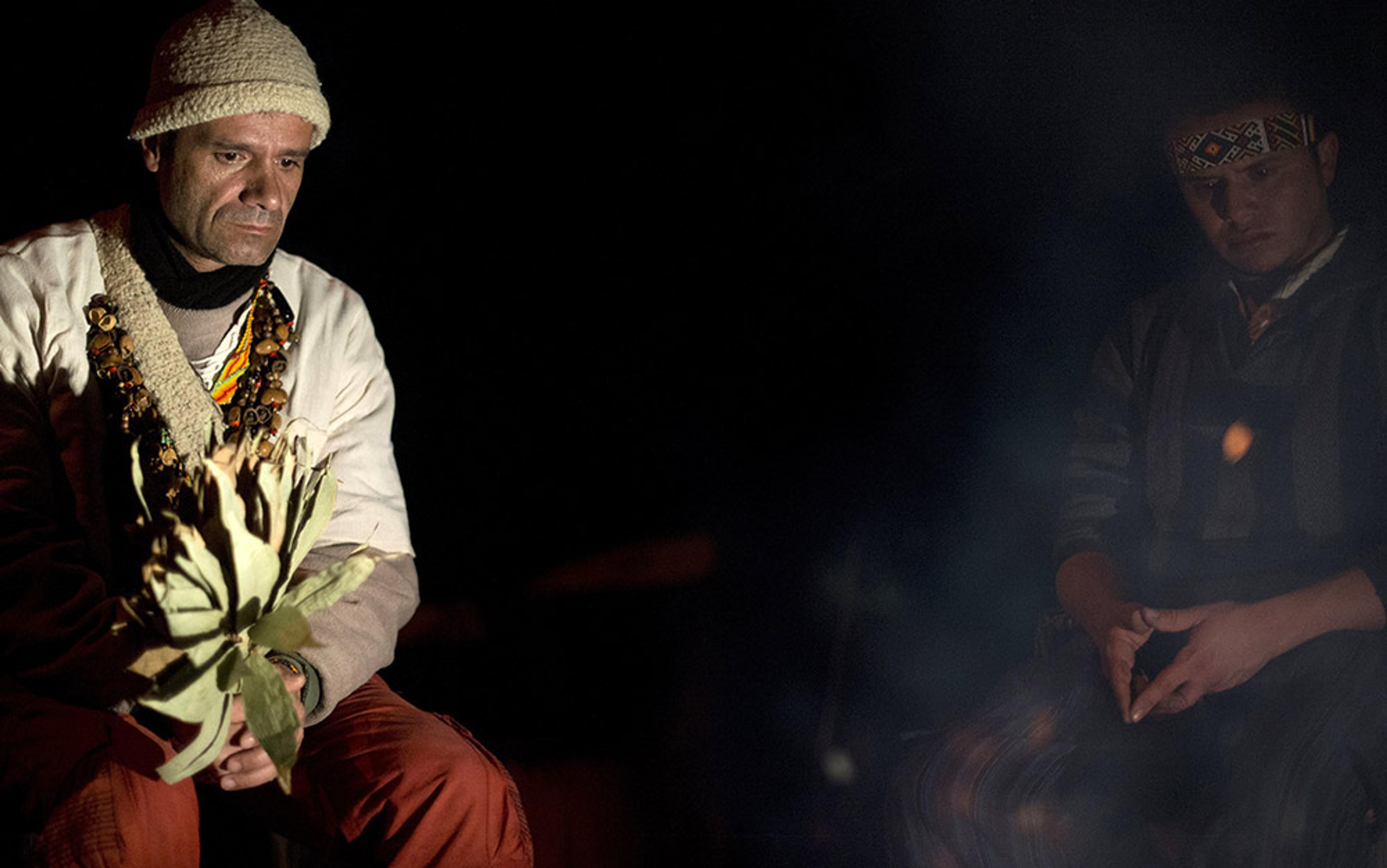Now as he was going along and approaching Damascus, suddenly a light from heaven flashed around him. He fell to the ground and heard a voice saying to him: ‘Saul, Saul, why do you persecute me?’ He asked: ‘Who are you, Lord?’ The reply came: ‘I am Jesus, whom you are persecuting. But get up and enter the city, and you will be told what you are to do.’
– from the New Revised Standard Version Bible, Acts 9:3-6
We have all heard stories of sudden self-transformation, or what the US psychologists William Miller and Janet C’de Baca call ‘quantum change’, whether it’s the religious conversion of Saint Paul on the Road to Damascus, the enlightenment of Siddhartha Gautama the Buddha, addicts at rock-bottom finding God, or near-death experiences that give people a new outlook on life. But not all sudden – or seemingly sudden – changes of outlook and personality are beneficial. The onset of psychosis in particular involves a strikingly similar transformation of reality, but one that precedes a frightening descent into mental illness. Consider this experience of psychosis, described in The Exploration of the Inner World (1936):
Strange and mysterious forces of evil of which before I had not had the slightest suspicion were also revealed. I was terrified beyond measure … There is probably no three-weeks period in all my life that I can recall more clearly. It seemed as if I were living thousands of years within that time …
Amazingly, the author of this account, Anton Boisen, snapped out of his psychosis one night with a sudden realisation: the giant cross he saw covering the Moon, which he previously interpreted as a clear sign of impending catastrophe, was actually a visual illusion caused by the wire screen outside his hospital window. Boisen went on to become a hospital chaplain and pioneer of clinical pastoral education. He noted that the early stages of schizophrenia often feature similar preoccupations with cosmic catastrophe and change, senses of being on a personal mission, commonly preceded by an initial period of panic, terror or paranoia.
Take this description of a first episode of psychosis in Memoirs of My Nervous Illness (1903), in which the German judge Daniel Paul Schreber experienced the precise trajectory outlined by Boisen. After an acute onset of panic and terror lasting some weeks, came a profound change:
It was as if single nights had the duration of centuries, so that within that time the most profound alterations in the whole of mankind, in the Earth itself and the whole solar system could very well have taken place … since the dawn of the world there can hardly have been a case like mine, in which a human being entered into continual contact, that is to say no longer subject to interruption, not only with individual departed souls but with the totality of all souls and with God’s omnipotence itself.
Schreber believed he was different from all the ‘seers of spirits’ who came before him, such as Joan of Arc, by virtue of his uninterrupted contact with forces that other people cannot perceive. But having read and witnessed similar accounts of psychosis, I can say with confidence, and echoing Boisen, that Schreber’s experiences were far from unique. To take one more example, consider John Custance, the pseudonymous author of Wisdom, Madness and Folly: The Philosophy of a Lunatic (1951), who described a similar closeness to God during a manic phase of bipolar disorder:
I feel so close to God, so inspired by His Spirit that in a sense I am God. I see the future, plan the Universe, save mankind; I am utterly and completely immortal; I am even male and female. The whole Universe, animate and inanimate, past, present and future, is within me.
What can account for the striking similarities in these sudden transformative experiences, some of which presage mental illness, while others lay the foundation for spiritual renewal and a galvanised sense of purpose? Are these really two versions of the same underlying psychological process?
One way to approach this puzzle is to first get a handle on the degree of overlap, including considering the prevalence of religious delusions or spiritual themes in psychosis. This is difficult to estimate, but if we take ‘spiritual’ to mean perceiving, communicating with and being influenced by forces (eg, spirits) that other people are not aware of, then the presence of spirituality in psychosis is high. On the other hand, if we think of spirituality as something loving, not exactly religious, but more secular and slightly abstract, then the overlap between spiritual epiphanies and psychosis is not so obvious.
Another approach is to flip things around – how many accounts of sudden religious epiphany and transformation include features of psychosis? Again, this depends partly on how we define psychosis. If we take the diagnostic criteria for ‘psychotic disorders’ according to US psychiatry (as outlined in the DSM-5 manual), delusions and hallucinations are a defining feature. And it’s notable then that delusions or false beliefs of grandiosity, persecution and impending catastrophe are alluded to in all the aforementioned religious quotes, as are hallucinatory visions.
The grey area of overlap is especially striking when we focus on hallucinations. If a person sees or hears things that aren’t there (or that others can’t see or hear), when is that a hallucination as opposed to a religious or spiritual vision? It depends to some extent on the context, content and interpretation of the experience, and whether these conform to cultural norms. Consider the conversion experience of Saint Augustine of Hippo as recorded in his Confessions (397-400 CE). We are presented here with what appears to be a mild yet impactful auditory hallucination. However, the context, content and interpretation of the experience is likely to resonate with some fellow Christians, normalising what could otherwise be interpreted as a pathological experience:
So was I speaking and weeping in the most bitter contrition of my heart, when, lo! I heard from a neighbouring house a voice, as of boy or girl, I know not, chanting, and oft repeating: ‘Take up and read; take up and read.’ Instantly, my countenance altered, I began to think most intently whether children were wont in any kind of play to sing such words: nor could I remember ever to have heard the like. So checking the torrent of my tears, I arose; interpreting it to be no other than a command from God to open the book, and read the first chapter I should find. For I had heard of Anthony, that coming in during the reading of the Gospel, he received the admonition, as if what was being read was spoken to him: ‘Go, sell all that thou hast, and give to the poor, and thou shalt have treasure in heaven, and come and follow me’: and by such oracle he was forthwith converted unto Thee …
Augustine is referring to Saint Anthony the Great, father of all monks in the Christian tradition. After Anthony’s parents died when he was 20 years old, he wandered out into the desert, living a life of solitude for 20 years, battling demons whenever they emerged to harass him. According to the biographer Athanasius, Anthony won these battles, just as Jesus bested the devil and as Siddhartha withstood the demon Māra.
Some of the warning signs in schizophrenia are also present in the lives of many religious exemplars
Here is a major clue to the parallels between sudden psychotic episodes and religious epiphanies – it’s the mythical idea, endlessly repeated and very hard to shake, that the same struggles that can lead to spiritual breakthrough or heroic deeds also risk destroying an individual or, in other words, triggering mental dysfunction. As Boisen put it:
The conclusion follows that certain types of mental disorder and certain types of religious experience are alike attempts at reorganisation. The difference lies in the outcome. Where the attempt is successful and some degree of victory is won, it is commonly recognised as religious experience. Where it is unsuccessful or indeterminate, it is commonly spoken of as ‘insanity’.
According to this view, the same fundamental underlying psychological processes can lead to sudden change that culminates in either illness or revelation and personal growth. As Boisen also notes, this implies there must be certain accompanying conditions or factors that lead to one outcome or the other. Understanding more about the human capability for sudden transformation and the contextual factors that channel that potential in different directions is a critical challenge for psychology. It is true that a vulnerability to psychosis develops over time, and it is easy to see patterns in retrospect. However, it is also true that despite our best scientific efforts to understand the psychotic prodrome (ie, the period of unusual experiences leading up to a first episode of psychosis), only about a third of individuals at ultra-high risk of psychosis – many of whom report brief, limited and intermittent psychotic symptoms – will actually go on to be diagnosed with a psychotic disorder. Moreover, some of the warning signs in the schizophrenia prodrome are also present in the lives of many religious exemplars, such as a sudden disinterest in material goods or worldly pursuits, as well as increased interest in solitude and spiritual domains.
In other words, there does not appear to be a set-in-stone developmental trajectory, nor a particular kind of one-off challenging experience, that is earnest of one outcome or the other. To help make sense of what is going on in all these stories of sudden transformation, the British psychologist and neuroscientist Robin Carhart-Harris and I recently introduced the construct of ‘pivotal mental states’ (or PiMSs), which we see as an evolved human capability for sudden and radical psychic change. In our paper in the Journal of Psychopharmacology in 2020, we defined PiMSs as ‘hyper-plastic state[s] aiding rapid and deep learning that can mediate psychological transformation’. We believe that the spiritual or incipient psychotic experiences that can lead to religious conversion or psychotic disorder, respectively, are both examples of PiMSs, as are the acute traumatic experiences that can lead to post-traumatic stress disorder, post-traumatic growth, or some combination thereof.
Crucially, we believe that shared neurobiological processes underlie all these intense transformative experiences, whether they culminate negatively or positively. Specifically, we propose that chronic stress primes and acute stress triggers PiMSs by increasing the expression, sensitivity and activity of a specific neurochemical receptor in the brain – the serotonin 2A receptor (also known as 5-HT2AR). Past work has shown that activation of the 5-HT2AR increases neuroplasticity, thereby facilitating certain forms of learning that might help an individual overcome challenges. Critical to our proposal is that pivotal mental states can function to promote radical transformation, but that they can also function as a key step toward maladaptation, and that this could help explain the commonalities in stories of dramatic personal transformation, whether revelatory or pathological.
We believe that the divergent outcomes of pivotal mental states are context dependent, and we mean context in the broadest possible sense of the word, including genetic susceptibility, prenatal development, early life experience, adolescence, young adulthood, and then of course the immediate context surrounding a specific pivotal experience. To appreciate the importance of the immediate context, consider the following two hypothetical cases.
First, a monk embarks alone on a spiritual retreat in the woods with blessings from his community. He takes no food or shelter, exposing himself to the elements, and sleeps very little. The monk stays like this for 30 days with the intention of deepening his connection to God. Second, imagine a political prisoner is forced into solitary confinement and deprived of food, water and adequate clothing. The lights in his cell are kept bright and the prisoner cannot sleep well. He is humiliated and interrogated by his captors. He does not know how much time has or will pass in this state. The prisoner is forced to endure at the mercy of his captors.
Both scenarios are acutely stressful and likely to trigger PiMSs. The difference lies in the social contexts in which the physiological stressors (fasting, sleep deprivation, exposure) are embedded. The monk consents to his experience, welcomes the presence of benevolent agency (eg, God), and prepares for positive change. Our prisoner does not consent, and prepares to resist the influences of what he perceives to be malevolent agents (his captors). It is more likely that our monk will have a spiritual experience, and our prisoner a transient psychotic or dissociative reaction, due to differing immediate circumstances.
However, there is clearly more to these experiences than the immediate context. What if our monk embarks on his retreat with suspicious, bizarre and disorganised thoughts, exhibiting odd behaviour and a dishevelled appearance? Does the likelihood of emerging psychotic symptoms seem more likely? What if the monk has a history of psychotic experiences? Certainly, the personal history of our monk is an important element of context. We would say the same for our prisoner. If he is amenable to the worldviews of his captors, perhaps the psychological outcome for him would be different.
The capability of humans to undergo radical psychological change in response to intense stress helps to make sense of cultural practices going back thousands of years – why peoples all over the world, some very isolated, use similar practices of food, sleep and sex restriction, isolation, bodily pain, intense endurance activities and temperature manipulation to induce spiritual experiences.
Having said that, of course most stress-related psychotic, spiritual or traumatic experiences are not wilfully induced. Rather, they manifest naturally in response to social loss, despair, physical illness, metabolic disturbance or extreme danger. Exposure to various stressors during development also primes individuals for PiMSs later in life. These include prenatal stressors, such as maternal infection or starvation, early life stressors such as childhood trauma, social stressors during adolescence and young adulthood, and subjective stressors, such as a failure to live up to one’s own expectations.
Interpersonal relationships rise to the forefront of awareness, accompanied by revisions of life priorities
Central to our model is that classic psychedelics, such as LSD, psilocybin, DMT and mescaline, act on the same serotonin receptors in the brain that we believe are fundamental to the biological basis of PiMSs – a fact that means psychedelic research could provide valuable insights into the nature of PiMSs. Consistent with our view, psychedelics can induce both psychotomimetic (psychosis-mimicking) and entheogenic (eliciting the divine or sacred) effects. Indeed, transient psychedelic experiences might be a microcosm of PiMSs – there are often challenging moments during a trip that sometimes resemble psychosis, and also mystical-type or peak experiences that could be called spiritual. It is quite common for the challenging moments to present first, followed by a cathartic release and resolution of distress. The neuroscientist Leor Roseman and his collaborators call this process ‘emotional breakthrough’. You could see it as a short-duration, chemically induced version of what Boisen thought of as essentially a ‘problem-solving experience’ – the spiritual struggle.
According to Boisen, a good outcome from spiritual struggles is increased socialisation and unification with common ideals, which in turn often resolves the acute disturbance. A bad outcome is an enduring psychosis, or a less severe form of schizotypal withdrawal from one’s peers. However, Boisen was disheartened by the fact that he could not help the majority of institutionalised patients recover from severe psychosis with psychospiritual support. This likely reflects a medical fact: a severe dysfunction that develops over time cannot always be reversed by treating its original causes.
Psychosis is particularly confusing in this regard, because a cognitive compensation for an original problem or cause of dysfunction, such as social threat or loss, can, over time, develop into the primary problem (such as delusional thinking). It makes sense that the same biological systems that we rely on to adapt to environmental demands can also promote the formation of maladaptive beliefs. For example, dopamine signalling regulated by the 5-HT2AR could play a key role in resolving acute distress or confusion, and yet a developmental dysregulation of these systems by stress or drugs in genetically susceptible individuals could eventually lead to psychosis and require antipsychotic intervention. Consistent with this view, some recurrent psychoses could reflect a repeated, yet dysfunctional, attempt to solve a social problem (eg, via delusional beliefs), which generally makes the problem only worse.
The social nature of the ‘problem-solving experience’ (what Carhart-Harris and I would call the pivotal mental state), which was clear to Boisen, is also reflected in the social nature of the psychedelic experience, where interpersonal relationships often rise to the forefront of awareness and are accompanied by revisions of life priorities. Consider a vision that a research participant called Mike had after ingesting psilocybin, the active compound in magic mushrooms, in a clinical trial testing the effects of psychedelic therapy on anxiety associated with cancer diagnosis:
Bit by bit, my daughters were turning into these radiant beings, cleansed of all these fears. It was incredibly emotional, because it was something I have, as their father, long known, but it’s a very great pain when you see your children being victimised by fears … to see these beautiful beings not realising their essence.
I cannot speak to Mike’s intentions, but it is common for people who use psychedelics with the intent of resolving personal distress to realise or remember via a cathartic experience just how deeply interpersonal their problems, solutions and priorities are. In this case, Mike envisioned the resolution of a social problem – the fears of his daughters.
Contemporary research into psychedelics and social theories of psychosis converge on the notion that pivotal mental states, whether manifested in psychedelic, spiritual or incipient psychotic experiences, often reflect an attempt to resolve social problems. If this is true, it raises an obvious question – why then are these various transformative experiences so often triggered by apparently non-social causes? To answer this, it’s important to remember that the serotonin system is evolutionarily ancient, and contributes not only to resolving social problems and distress, but also to addressing basic homeostatic challenges and other physiological functions.
Activation of the 5-HT2ARs that underlie PiMSs likely has both neuroprotective and neuroplastic effects, probably mediated by common downstream mechanisms, such as the release of brain-derived neurotrophic factor, a protein that promotes both the survival of neurons as well as the growth and maintenance of synaptic connections. In this way, a near-death experience during cardiac arrest or an experience of time expansion during a car crash could be the subjective correlate of a brain protecting itself from immediate damage, and yet also provide an added opportunity for learning. The US neuropharmacologist Kevin Murnane suggests that 5-HT2AR activation in response to extreme danger promotes fast and drastic learning conducive both to survival and also, unfortunately, to the development of post-traumatic stress disorder. Similarly, stressful events may provide an opportunity for post-traumatic growth or positive personality change.
Naturally occurring spiritual experiences function to reorient us in times of danger, need or desperation
Recognising that spiritual experience and psychosis are related, both in terms of subjective experience and neurobiology, creates challenges and opportunities. We can easily distinguish between spiritual wellbeing and dysfunctional psychosis but there is a middle ground, including for example spiritual emergencies, where the distinction is not so clear. Thankfully, for the great majority of people interested in using psychedelics or spiritual methods for personal development, psychosis is not a likely outcome. In addition to using drugs responsibly, we can also promote positive outcomes and protect against pathology by striving to embrace virtues, such as humility and temperance, or the related Buddhist ideals of selflessness and equanimity.
More than a decade ago, I was dancing in a field and calling on God to answer a question: why do we have the capacity for exalted states of consciousness, and why are these states typically either temporary and helpful, or enduring and symptomatic of dysfunction? Silence ensued, so I pursued the question, and received the following message in the form of a quote impressed upon my consciousness: ‘Stop calling if you are not in danger. Go home, have a glass of red wine, and have sex with your girlfriend.’
At first, I took this as a clear directive to return to the mundane pleasures and pursuits of a worldly existence. I was not meant to live in paradise and should humble myself in pursuit of the ecstatic. But then I thought, here also is the answer to my question – naturally occurring spiritual experiences function to reorient us in times of danger, need or desperation. Perhaps this is why stimulation of the serotonin 2A receptor, part of a system that regulates psychological responses to stress, elicits what Carhart-Harris and I describe as pivotal mental states. Perhaps this in turn helps to explain why all religions are interested in salvation, which outside of theological contexts can be defined as a ‘preservation or deliverance from harm, ruin, or loss’.
The idea that adversity presents us with an opportunity for change is familiar to all of us in the form of a story. The US author and teacher Joseph Campbell called it the monomyth or the hero’s journey: it is the ubiquitous story arc of struggle, adaptation and overcoming that applies to so many myths. These periods of disillusionment or crisis can lead to a life-changing spiritual experience – or a psychotic episode. Either way, they indoctrinate us all into the cult of humanity.
To read more on altered states of mind, visit Psyche, a digital magazine from Aeon that illuminates the human condition through psychology, philosophy and the arts.






